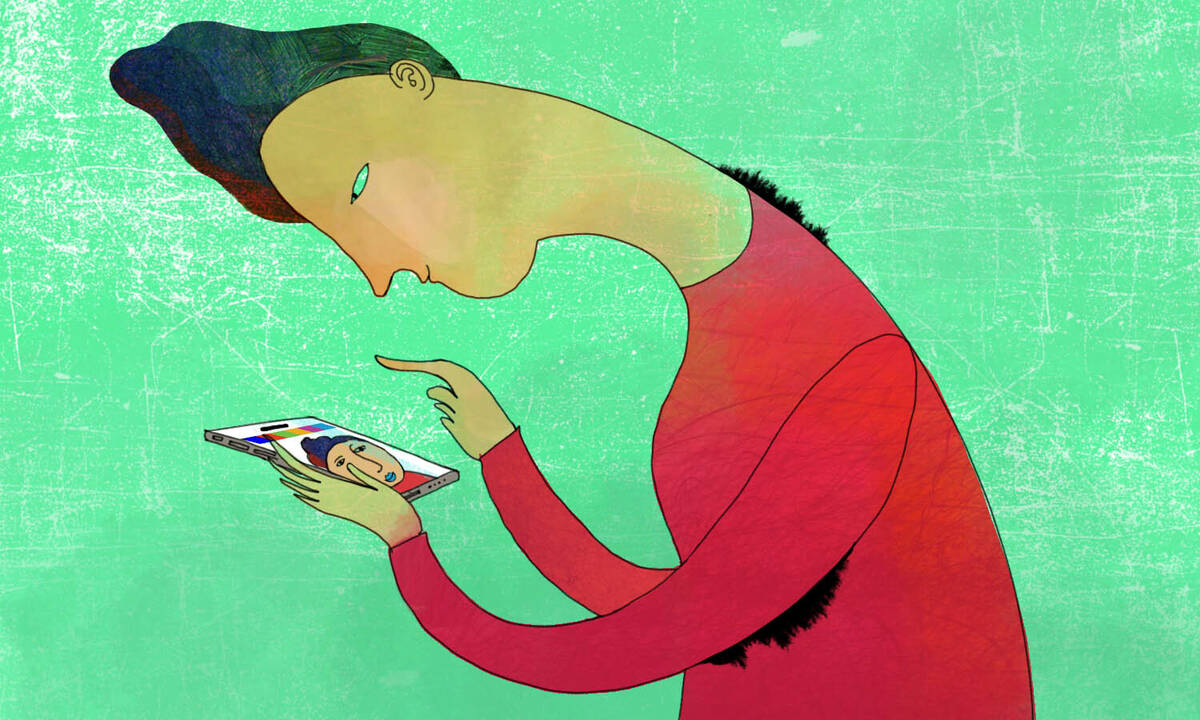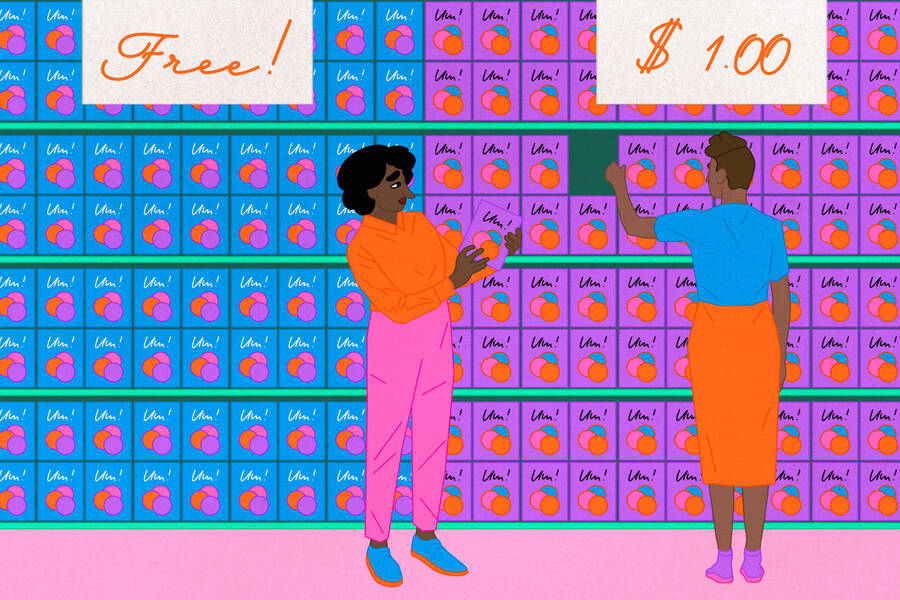Marketing Feb 1, 2023
Got a Niche Product to Sell? Augmented Reality Might Help.
Letting customers “try out” products virtually can give customers the confidence to take the plunge.

Yevgenia Nayberg
Buying new products online that you haven’t used, or even seen, in real life can feel risky. You’re left guessing: How would that red couch look in my living room? Would these glasses fit my face? Could I really pull off blue lipstick?
Over the past decade, augmented reality (AR) technology has eased this uncertainty. By superimposing virtual objects onto a live view of physical environments, AR helps users visualize how products would fit into their world. Across industries, retailers have built apps to help consumers virtually try out products—including furniture, glasses, and makeup—with the hopes of attracting customers and ultimately increasing sales.
Because this technology is relatively new, little research exists on just how much it improves sales for different products or customers. In a recent study, Srinivas K. Reddy, a visiting professor of marketing at Kellogg, and his collaborators Sandeep R. Chandukala of Singapore Management University and Yong-Chin Tan of City University of Hong Kong set out to change that.
Using data from an international cosmetics retailer, the team found that AR usage on the retailer’s mobile app changed customer behavior in several ways. In addition to boosting overall sales, it led to higher sales for less-popular brands, as well as for expensive products and for products with narrower appeal. The effect was greatest with customers who were new to the app or the product category.
“Many retailers have implemented this technology because it is cool, but many haven’t looked into what kind of insights it provides,” Reddy says. “What we show is that it does engage customers, it does increase purchasing rate, and it does level the playing field for less-familiar brands and products.”
The promise of AR in retail
AR technology has been touted for years by tech execs as having the ability to transform our everyday experiences. “At some point, we’re going to look back and think, how did we not have a digital layer on the physical world?” said Greg Jones, then-director of virtual reality and augmented reality at Google, in 2017. In fact, research estimates that close to 100 million consumers use AR technology regularly.
For retail settings in particular, Reddy and his coauthors identify four broad uses of AR technology: to entertain, to educate, to help consumers evaluate product fit, and to enhance their post-purchase experience.
For example, when Walmart collaborated with DC Comics and Marvel to bring superhero-themed AR games to their stores, it created entertaining, novel experiences for customers. Auto manufacturers like Toyota and Hyundai have used AR to educate consumers about innovative technologies, while IKEA’s Place app uses AR to give customers a preview of how furniture will look in their homes, allowing them to evaluate the fit before purchase. And LEGO launched several brick sets with a companion AR app that allowed characters to come to life and interact with physical LEGO sets after they’d been purchased.
“Customers have never purchased blue lip shade, and now suddenly they buy it. And if this reduces their uncertainty, they are also willing to spend more.”
—
Srinivas Reddy
Reddy and his colleagues decided to focus on studying customer behavior when they were using AR to evaluate a product. They obtained a data set from an international cosmetics retailer that incorporates AR into its mobile app to help customers visualize how they would look if they used different cosmetic products, such as eyeshadows and lipsticks.
The dataset contained sales records for 2,300 products, and browsing and purchase histories for 160,400 customers in a key market in Asia Pacific. The data covered a 19-month period from December 2017 to June 2019. Consumers could use the AR feature for lipstick and lip gloss during that entire time; the AR feature for eyeshadow and eyeliner was introduced in March 2018.
The dataset covered more than 800,000 shopping sessions, around 20 percent of which involved AR.
AR increases purchases from less-established brands
The researchers found that customers who used AR as part of their mobile-app shopping experience spent 20 percent more time browsing (and browsed nearly 30 percent more products). In addition, these customers’ purchase rate was nearly 20 percent higher than that of those who did not use AR.
The overall effect is largest for customers who are new to the app or the product category—showing that AR has the opportunity to promote online shopping adoption and category expansion. But it was also successful with the company’s regular, loyal shoppers.
Because the researchers had access to many of these shopper’s browsing and shopping histories, they could also compare how their purchases differed when they used AR versus when they did not. And they found a few surprises.
When customers used the AR feature, they bought products from less-popular brands and also purchased more expensive and unusual products. That’s likely because the AR system allowed them to take a chance on what would otherwise seem like riskier bets.
Indeed, research has shown that when consumers have access to more information about the product, as they do with AR interfaces, they rely less on branding as an indicator of quality.
These interfaces also reduce uncertainty by letting customers visualize how products would look on their faces, perhaps leading them to feel more comfortable investing in more-expensive or less-familiar products.
“This shows augmented reality is leveling the playing field for brands and products,” Reddy says. “Customers have never purchased blue lip shade, and now suddenly they buy it. And if this reduces their uncertainty, they are also willing to spend more.”
Deciding if AR is right for a retailer
One big implication for marketers, then, is that AR is most effective when customers feel a lot of risk or uncertainty around the purchase process. That means AR might work best for less-established brands and for customers who are new to the channel. It could also help replace expensive “try before you buy” programs or help customers feel comfortable with customized products that often cannot be returned.
Of course, AR isn’t right for every retail category. It doesn’t allow consumers to feel texture or smell scents, for example (though that sort of technology is in development). And AR is not a cheap investment. Customized AR applications cost anywhere from $10,000 to $300,000.
Yet AR retail experiences aren’t just limited to mobile apps. Reddy and his collaborators are currently examining a dataset from an AR interface placed within this cosmetic retailer’s physical stores. The interface allowed shoppers to virtually try on lipsticks (without physically applying anything to their lips, the normal process of testing products at stores). Initial results show that customers who used the AR interface spent more time sampling more kinds of lipsticks, suggesting that by making the sampling process more convenient, it encourages shoppers to explore more than they usually would.
Reddy ultimately hopes to explore how AR usage affects customers’ purchases over time. Was that blue lipstick a one-off purchase? Or does this new behavior continue?
“We want to understand whether AR helps customers continue to explore and experiment,” Reddy says. “That will help us understand the value of AR over the long run.”
Emily Ayshford is a freelance writer in Chicago.
Tan, Yong-Chin, Sandeep R. Chandukala, and Srinivas K. Reddy. 2022. “Augmented Reality in Retail and Its Impact on Sales.” Journal of Marketing. 86(1): 48–66.



